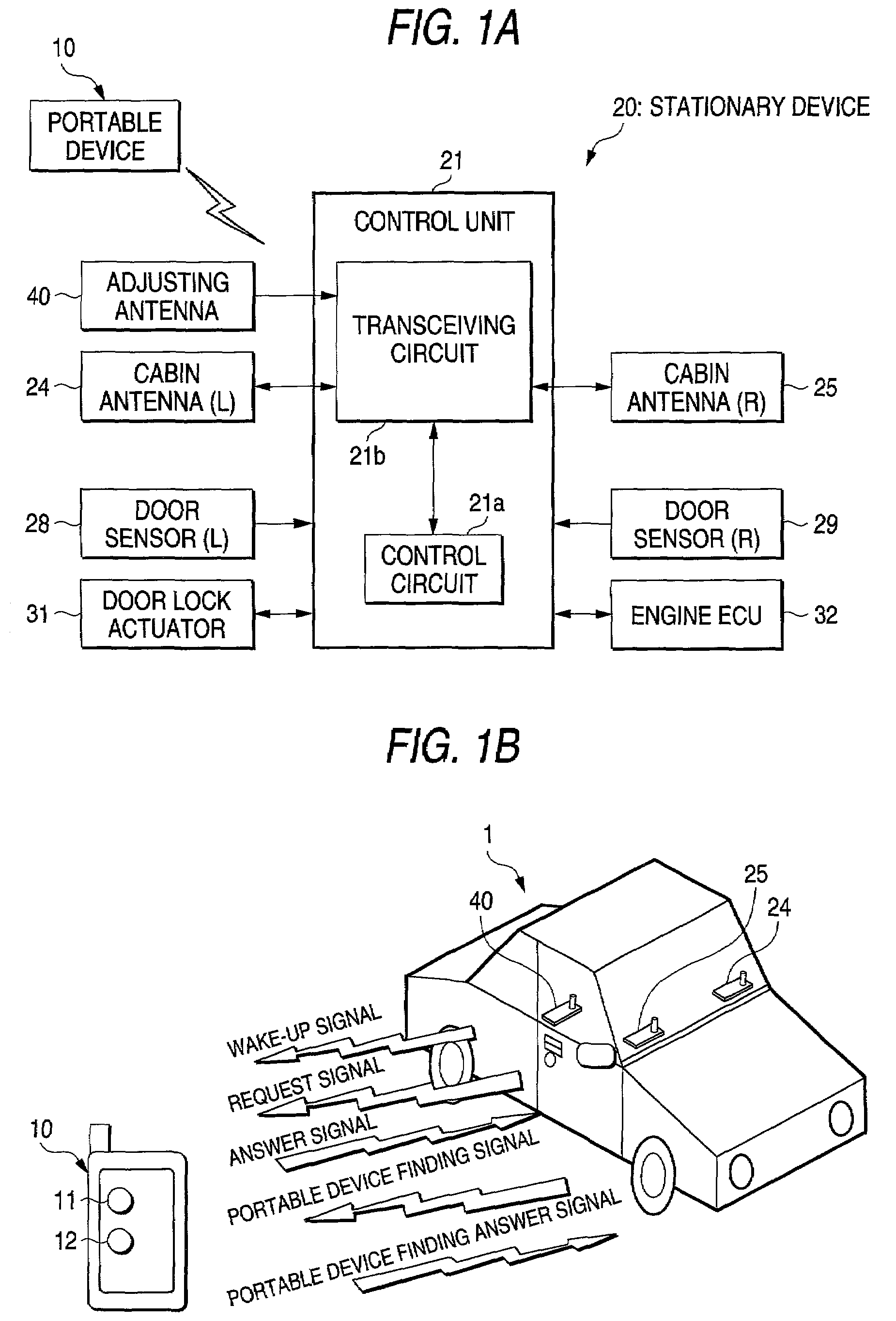Radio system
a radio system and radio technology, applied in the field of radio systems, can solve problems such as the inability to determine the absolute position of portable devices
- Summary
- Abstract
- Description
- Claims
- Application Information
AI Technical Summary
Benefits of technology
Problems solved by technology
Method used
Image
Examples
first embodiment
[0054]A first embodiment of the present invention will first be described. In the embodiment, the present invention is applied to a radio system for an entry system and an engine control system (with the immobilizer function) in a motor vehicle 1 of the two door type, as shown in FIG. 1B.
[0055]The radio system, as shown in FIG. 1A, includes a portable device 10, a stationary device 20 mounted on the motor vehicle 1, and an adjusting antenna 40 for adjusting a transmission output power.
[0056]In FIG. 1A, reference numerals 28 and 29 are door sensors for sensing the opening and closing of the right and left doors of the motor vehicle 1. Reference numeral 31 is a door lock actuator as a drive power source for a door lock device of the motor vehicle 1. Reference numeral 32 is a control unit for an engine control system of the motor vehicle 1.
[0057]Those sensors 28 and 29 are used for triggering the position determining process of the portable device and the selecting (adjusting) process ...
second embodiment
[0121]A second embodiment of the invention will be described. In the second embodiment, a part of the FIG. 5 process of the first embodiment is modified.
[0122]In the process of selecting the transmission output power (step S1 in FIG. 5), an output adjustment process as shown in FIG. 6 is executed for each selection, and the transmission output power in the engine start / stop control mode is set (adjusted) to a preferable value for each selection. The transmission output power adjusting technique to be described hereunder may be applied to the adjustment of the transmission output power of the portable-device finding signal (the same thing is true for other embodiments to be described later).
[0123]In this case, the control circuit of the portable device 10 having received the mode select report signal sets a parameter N (integer) used for determining the transmission output power to “1” (step S21). Then, the adjusting transmission output power of the transceiving circuit of the portab...
third embodiment
[0133]Now, a third embodiment of the invention will be described. Also in this embodiment, the FIG. 5 control process in the first embodiment is modified partly.
[0134]In the embodiment, an output power adjusting process shown in FIG. 5 is adjusted every time the output power selection of the step S11 in FIG. 5 is executed. The transmission output power for the engine start / stop control mode is optimized every output power selection.
[0135]In this case, the control circuit of the portable device 10, when receiving the mode select report signal, first sets the parameter N (integer) for determining the transmission output power to “10” (step S31). Thereafter, the transmission output power for adjustment of the transceiving circuit of the portable device 10 is set to “KN” (step S32)
[0136]Then, the control circuit of the portable device 10 sends an adjusting signal of the output power KN (step S33).
[0137]Then, the control circuit judges whether or not the reception ready signal containing...
PUM
 Login to View More
Login to View More Abstract
Description
Claims
Application Information
 Login to View More
Login to View More - R&D
- Intellectual Property
- Life Sciences
- Materials
- Tech Scout
- Unparalleled Data Quality
- Higher Quality Content
- 60% Fewer Hallucinations
Browse by: Latest US Patents, China's latest patents, Technical Efficacy Thesaurus, Application Domain, Technology Topic, Popular Technical Reports.
© 2025 PatSnap. All rights reserved.Legal|Privacy policy|Modern Slavery Act Transparency Statement|Sitemap|About US| Contact US: help@patsnap.com



